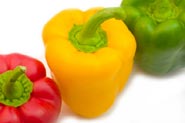Vegetarianism
 When yoga was first created, it was not intended to be an exercise regimen but rather an all-inclusive way of life. The techniques learned through yoga can serve as life lessons that apply to all kinds of situations. Because yoga attracts such a diverse following, not everyone sees yoga as a way of life, and even if a loyal follower does, they may incorporate yogic teachings into their own life rather that using the tools as a guideline for life.
When yoga was first created, it was not intended to be an exercise regimen but rather an all-inclusive way of life. The techniques learned through yoga can serve as life lessons that apply to all kinds of situations. Because yoga attracts such a diverse following, not everyone sees yoga as a way of life, and even if a loyal follower does, they may incorporate yogic teachings into their own life rather that using the tools as a guideline for life.
Eating a strictly vegetarian diet is difficult for a lot of people, but it is ideal for a yogi to adhere to this type of eating regimen. For those who fully commit to being a traditional yogi, vegetarianism is a must, or rather a should-do. Although it can be difficult at first, one must remember that humans do not need to consume the meat of another animal to survive, and no single person should provoke or endorse suffering in another creature whether it be an animal or another human, especially if the ending results in their own personal pleasure.
Protein is an important part of any diet, especially a vegetarian’s because meat is traditionally the main source of a person’s protein intake. Meat should be replaced with soy, nuts, beans, eggs, and other sources of protein. Many vegetarians make the same mistake by eating more servings of carbohydrates than necessary as a filler in their diet. When eating out, vegetables and pasta are all that’s left of the menu after seafood, chicken, pork, beef, and lamb are eliminated; packaged food mainly consists of carbohydrates; quick drive-through meals tend to be mainly meats or carbohydrates, and of course a vegetarian would pick the fries, chips, or breads.
Eating a mainly vegetable and bean diet can become monotonous, but there are simple ways to modify your diet so you get the correct amount of protein and vegetables while still enjoying the foods you eat and drinks you consume. Below are some tips for eating vegetarian, so you stay healthy and eat a variety of foods that balance the body while appealing to you.
- Soy comes in many forms: soy milk and other soy drinks, soy powder, soy tablets, tofu – try them all!
- Meat substitutes are a great way to eat foods you may crave as a vegetarian while getting a sufficient amount of protein and vegetables with your meal. Eat these meat substitutes alone or in stews, between burger or hot dog buns, in a salad, or any other way you would consume real meat.
- Eat plenty of vegetables in salads, steamed, cold cut, in soups, or any other way you wish to consume them. It is, however, healthiest to eat vegetables in their raw form but this can become boring. If you can, incorporate legumes in with your vegetables as often as possible. Fruit is also a necessary part of any person’s diet and is most effective when consumed fresh, however it can be dried, cooked, steamed, and dipped as well.
- Eggs are a great source of protein, but can be high in calories and cholesterol. One option is to eat only the whites of eggs.
- Nuts are rich in protein as well as the right kinds of fats. They are great alone or in salads. Peanut butter is a great source of protein, but eat in moderation because it is high in fat and calories.
Drink plenty of water and natural fruit and vegetable juices, but beware of the salt and sugar content of the juices.
